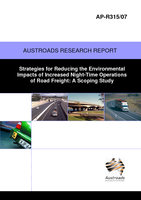Freight

Strategies for Reducing the Environmental Impacts of Increased Night-Time Operations of Road Freight: A Scoping Study
- Publication no: AP-R315-07
- ISBN: 978-1-921329-31-9
- Published: 30 October 2007
- PDF (free) Download
It is predicted that the Australian road freight task will more than double between 2000 and 2020. The Australian heavy vehicle industry estimates that the increased road freight task will result in the addition of approximately 50,000 trucks to the national heavy vehicle fleet between 2005 and 2020, approximately 28,000 of which are predicted to be large articulated trucks. The projected growth poses a significant challenge for road authorities throughout Australia and New Zealand in terms of how to best accommodate the increased number of vehicles and vehicle movements on metropolitan road networks that are already congested, without creating significant economic and social problems for communities. A possible consequence of this increased demand for road space will be increased movements of road freight vehicles at night, when the level of traffic congestion on metropolitan networks is likely to be relatively low (and freight movements in urban areas are most efficient). The increased night-time operation of road freight may, however, produce increased environmental and social impacts in urban areas. Potential environmental impacts include increased night-time noise and increased concentrations of vehicle-related pollution. In an effort to better understand these impacts (and the potential strategies that might be put in place to mitigate them) Austroads commissioned a study to explore the opportunities that may exist for the effective management of the potential night-time environmental impacts.
- AP-R315/07 Strategies for Reducing the Environmental Impacts of Increased Night-Time Operations of Road Freight: A Scoping Study
- CONTENTS
- SUMMARY
- 1. ABOUT THIS REPORT
- 2. BACKGROUND
- 3. POTENTIAL ENVIRONMENTAL IMPACTS
- 3.1. Increased night-time noise
- 3.2. Night-time air quality
- 4. NOISE EVENTS, SLEEP DISTURBANCE AND NIGHT-TIME NOISE LIMITS
- 4.1. Relationship between noise events and sleep disturbance
- 4.2. Night-time traffic noise limits
- 5. OPTIONS FOR THE MANAGEMENT OF DISCONTINUOUS TRAFFIC NOISE
- 5.1. Vehicle-based strategies
- 5.2. Metropolitan and local planning strategies
- 5.3. Road and roadside strategies
- 5.4. Industry strategies
- 6. ASSESSMENT OF OPTIONS
- 6.1. Assessment criteria
- 6.2. Assessments
- 6.3. Assessment criteria
- 7. SUGGESTED APPROACH
- 7.1. Strategic objective
- 7.2. Guiding strategic insights
- 7.3. Suggested strategies
- 8. CONCLUSIONS
- UK DEPARTMENT FOR TRANSPORT GUIDELINES
- BIBLIOGRAPHY
- GLOSSARY & ABBREVIATIONS
- INFORMATION RETRIEVAL
Related publications
Latest Freight News
